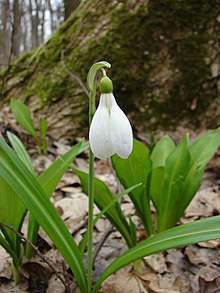Galanthus plicatus
Galanthus plicatus is a species of flowering plant in the family Amaryllidaceae, native from Romania, Ukraine and Crimea in eastern Europe to north Turkey and the north-west Caucasus in Asia.[1]
| Galanthus plicatus | |
|---|---|
 | |
| In habitat in Ukraine | |
| Scientific classification | |
| Kingdom: | Plantae |
| Clade: | Tracheophytes |
| Clade: | Angiosperms |
| Clade: | Monocots |
| Order: | Asparagales |
| Family: | Amaryllidaceae |
| Subfamily: | Amaryllidoideae |
| Genus: | Galanthus |
| Species: | G. plicatus |
| Binomial name | |
| Galanthus plicatus M.Bieb.[1] | |
Description
Galanthus plicatus is a bulbous perennial plant, growing to about 15 cm tall. Its leaves are bluish or greyish green, broader than many other species of Galanthus, up to 2 cm wide. The leaf edges are folded back away from the upper surface of the leaf, both in bud and after they expand. The nodding white flowers appear in spring and have six white tepals. The outer three are all white, 2–3 cm long; the inner three are shorter and notched, with a green mark above the notch, often extending to beyond the middle of the tepal.[2][3] In G. plicatus subsp. byzantinus, the inner tepals also have a green mark at the base.[3][4]
 Flower and leaves
Flower and leaves In habitat in Ukraine
In habitat in Ukraine
Taxonomy
Galanthus plicatus was first described by Friedrich Marschall von Bieberstein in 1819.[1] In 1893, Baker described Galanthus byzantinus from north-western Turkey as a separate species, differing in possessing green marks at the base as well as the tip of the inner three tepals. It is now usually treated as a subspecies of G. plicatus.[4][5]
Distribution and habitat
Galanthus plicatus is native from eastern Europe (Romania, Ukraine and Crimea) through Turkey to the north-west Caucasus.[1] G. plicatus subsp. plicatus is found throughout the range of the species,[6] G. plicatus subsp. byzantinus only in north-west Turkey.[7] The species is found in woodland and scrub, usually in shade.[2]
Cultivation
Galanthus plicatus[8] and the cultivar 'Three Ships' [9] are both recipients of the Royal Horticultural Society's Award of Garden Merit.
References
- "Galanthus plicatus", World Checklist of Selected Plant Families, Royal Botanic Gardens, Kew, retrieved 2017-12-28
- Grey-Wilson, Christopher; Mathew, Brian & Blamey, Marjorie (1981). Bulbs : the bulbous plants of Europe and their allies. London: Collins. p. 132. ISBN 978-0-00-219211-8.
- Mathew, Brian (1987), The Smaller Bulbs, London: B.T. Batsford, p. 99, ISBN 978-0-7134-4922-8
- Beckett, K., ed. (1993), "Galanthus byzantinus", Encyclopaedia of Alpines : Volume 1 (A–K), Pershore, UK: AGS Publications, p. 512, ISBN 978-0-900048-61-6
- "Galanthus byzantinus", World Checklist of Selected Plant Families, Royal Botanic Gardens, Kew, retrieved 2017-12-28
- "Galanthus plicatus subsp. byzantinus", World Checklist of Selected Plant Families, Royal Botanic Gardens, Kew, retrieved 2017-12-28
- "Galanthus plicatus subsp. plicatus", World Checklist of Selected Plant Families, Royal Botanic Gardens, Kew, retrieved 2017-12-28
- "Galanthus plicatus". RHS Plant Selector. RHS. Retrieved 7 July 2020.
- "Galanthus plicatus 'Three Ships'". RHS. Retrieved 7 July 2020.